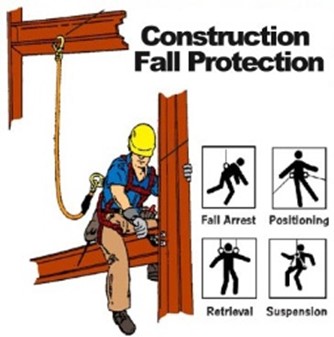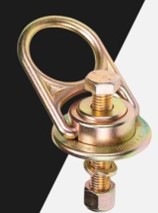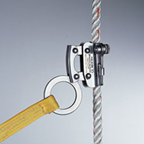
Anytime you are tasked to keep someone safe from falling, one decision must be made first. Do I select a passive system or an active system? Understanding the difference between passive and active fall protection is a great place to start.
Examples of fall protection systems:
- Perimeter guardrails
- Safety net
- Safety monitors
Passive Systems
A passive system, in short, requires no human interaction to function properly once installed. It has no active mechanisms or moving parts. These tend to be your guardrails and netting.
Netting will catch you regardless if you are paying attention or not. In other words, there is nothing for you to do to get passive systems to keep you safe.
Active Systems
Active fall protection requires human interaction to keep one safe. This could be:
- An anchor point
- Horizontal lifeline/vertical lifeline
- Overhead rigid rail, or anything that requires action from the worker to be safe
While working at heights, using an active system requires the worker to put on a full body safety harness, and then attach an acceptable lanyard to themselves, depending on their scenario. This could be anywhere from a shock-absorbing lanyard to a self-retracting lifeline.
Now assuming that the active system was engineered structurally, up to date with its visual and annual inspections, adequately trained workers and a rescue plan is in place, you might be safe.
We know that there are times when passive systems are not possible. Active systems have their place in this industry. With the knowledge of these two options, you are better equipped to select the best system for your scenario.
Fall Protection Required
There are two starting points that once reached, require fall protection. According to OHS Act, these heights are:
- General Industry requires fall protection for any worker over 1.2m
- Construction requires fall protection for any worker over 1.8m
This means that at any point your employees are exposed to heights equal to or greater than these, they must have some sort of protection to mitigate the risk of falling from height. If a fall safety solution such as a railing is not a realistic option, personal protective equipment such as harnesses, lanyards, and lifelines are required.
The “No Minimum Height” Rule
There is an instance in which there is no minimum height. If your employees are working over dangerous equipment, machinery, or any hazard into which they could fall, they must have fall protection at all times or machine guarding needs to be put into place.
Personal Fall Arrest Systems (PFASs) Consist of:



Anchorage
When a personal fall arrest system is used, these systems shall be tied-off properly to anchorage points, which are capable of supporting a static load of 5000 pounds (2268kg) per person attached; or as part of a complete personal fall arrest system that maintains a safety factor of at least 2 and is operated under the supervision of a qualified person.
Acceptable anchor points shall be determined by one of the following methods:
- The anchor point installation follows manufacturers’ specifications
- Engineering has documented approval of the anchor point
If a fall arrest has occurred, Engineering shall be contacted to inspect the anchor point for damage/corrective action. Anchor points are used to connect lanyards, lifelines, and other forms of tie-off which prevent a worker from falling.
Sound anchorages include structural members, but not standpipes, vents, other piping systems and electrical conduit.
Body harnesses are straps which may be secured to the body in a manner which will distribute fall arrest forces over the thighs, pelvis, waist, chest and shoulders, with a means to attach to other components of a PFAS.



Shock absorbing lanyards are made of webbing that is designed to stretch or rip open to limit impact forces onto the fall victim's body. They often have two legs which can each be attached for 100% connection to your structure for each leg.
A non-shock absorbing lanyard is only good for restraint. A lanyard needs a shock pack when it will be used for fall arrest. The shock pack helps absorb the kinetic energy that is created by a body in freefall.


Guided Type Fall Arrester Including a Rigid Anchor Line
The vertical anchor system is designed to protect the user throughout the climbing or descending of a ladder. The anchor line consists of a stainless steel cable, intermediate anchors and terminal anchors. The gliding shuttle (fall arrester) will block the fall of the user immediately and will dissipate the shock generated by the fall, having an integrated energy absorber.

Self-Retracting Lifeline
The housing or casing is the part you see which is what the lifeline itself winds on to.
Used properly, like most fall protection, the SRL (Self-Retracting Lifeline) should be anchored at the height of your harness’ D-ring or above. While some may hear “retractable” and think that the cable will pull you back if you begin to fall, this is not true. What is already played out will remain played out, so if you anchor the SRL at your feet, you are adding fall distance that can place too much force on your body. The very idea of the short arrest distance of an SRL is to keep those forces at very low, very safe levels. Using an SRL on a sloped roof could also be a problem as a fall that involves the worker slipping down the slope may not reach a high enough speed to engage the mechanism. Ensure that your SRLs are always properly installed and being used in accordance with the manufacturer’s instructions.
Click here to watch a video about fall restraint vs fall arrest.
All-protection systems play an important role in protecting employees from injuries due to a fall. There are many different types of systems, including guardrails, travel restraint systems, fall-arrest systems and the use of warning lines and safety monitors. Falls can happen from ladders, permanent structures like roofs, and temporary structures such as scaffolds and other types of work platforms.
Fall protection is also required when working from:
- Elevating work platforms
- Fixed suspended work platforms
- Boatswain’s chairs
- Suspended equipment
The best forms of fall-protection systems are those that prevent employees from falling and include guardrails (passive system) and travel restraint (active system).
Fall Arrest System
A fall arrest safety system typically includes an anchor point or series of anchor points, a safety lanyard or self-retracting lifeline, and a harness. This system must be designed to “arrest” or stop you before hitting the lower surface in the case of a fall. This gives you the freedom to walk all the way up to a fall hazard to do your work.

As an example, let's say you are unloading a flatbed truck; your walking/working surface is so narrow that any system that wouldn’t allow you near the edge would limit your movement. Where you need full access to your working surface, fall arrest is typically your better option.
Ascending and descending a fixed ladder is another great example of when fall arrest systems are effective.
Click here to watch a video about the ABCs of fall protection.